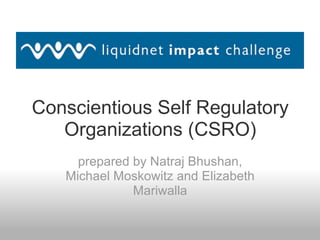Justmeans power point
•Télécharger en tant que PPT, PDF•
0 j'aime•245 vues
Justmeans power point
Signaler
Partager
Signaler
Partager

Recommandé
Recommandé
Greg Carson of XBTO Humla Ventures, Venture Capital/Digital Asset fund manager at the marcus evans Private Wealth Management Summit 2022, and the Elite Summit 2022, discusses the financial markets transformation, and what investment opportunities investors must consider. Why Investors Need to Enter the Decentralized Finance Space-Greg Carson, XBT...

Why Investors Need to Enter the Decentralized Finance Space-Greg Carson, XBT...Investments Network marcus evans
Contenu connexe
Tendances
Greg Carson of XBTO Humla Ventures, Venture Capital/Digital Asset fund manager at the marcus evans Private Wealth Management Summit 2022, and the Elite Summit 2022, discusses the financial markets transformation, and what investment opportunities investors must consider. Why Investors Need to Enter the Decentralized Finance Space-Greg Carson, XBT...

Why Investors Need to Enter the Decentralized Finance Space-Greg Carson, XBT...Investments Network marcus evans
Tendances (18)
Why Investors Need to Enter the Decentralized Finance Space-Greg Carson, XBT...

Why Investors Need to Enter the Decentralized Finance Space-Greg Carson, XBT...
Murtha Cullina - Crowdfunding and Angel Investors 2012

Murtha Cullina - Crowdfunding and Angel Investors 2012
Using Crowd-Centric Alternative Assets to Enhance Portfolio Yield

Using Crowd-Centric Alternative Assets to Enhance Portfolio Yield
The Changing Relationship Between Investors and Investments 

The Changing Relationship Between Investors and Investments
Flawed Market Structure Exacerbating the Great Wealth Divide

Flawed Market Structure Exacerbating the Great Wealth Divide
Employing crowdfunding to start or expand your business

Employing crowdfunding to start or expand your business
En vedette
En vedette (8)
Similaire à Justmeans power point
Similaire à Justmeans power point (20)
Crowdfunding - A disruptive financial innovation - May 16, 2014

Crowdfunding - A disruptive financial innovation - May 16, 2014
RocketHub Congressional Testimony - Regulation of Crowdfunding

RocketHub Congressional Testimony - Regulation of Crowdfunding
Dynamic startups in colombia eng (actualizado diciembre 2021)

Dynamic startups in colombia eng (actualizado diciembre 2021)
What Every Entrepreneur Should Know Before Taking Any Outside Investment

What Every Entrepreneur Should Know Before Taking Any Outside Investment
Profit with purpose businesses: Mission alignment paper

Profit with purpose businesses: Mission alignment paper
OECD Workshop: Measuring Business Impacts on People’s Well-being, Pierre Poret

OECD Workshop: Measuring Business Impacts on People’s Well-being, Pierre Poret
Private Public Intro to Social Impact Bonds and Community Interest Companies,...

Private Public Intro to Social Impact Bonds and Community Interest Companies,...
Democratising Finance, Alternative Finance Demystified: DealIndex Research

Democratising Finance, Alternative Finance Demystified: DealIndex Research
Plus de justmeanscsr
Plus de justmeanscsr (20)
Justmeans power point
- 1. Conscientious Self Regulatory Organizations (CSRO) prepared by Natraj Bhushan, Michael Moskowitz and Elizabeth Mariwalla